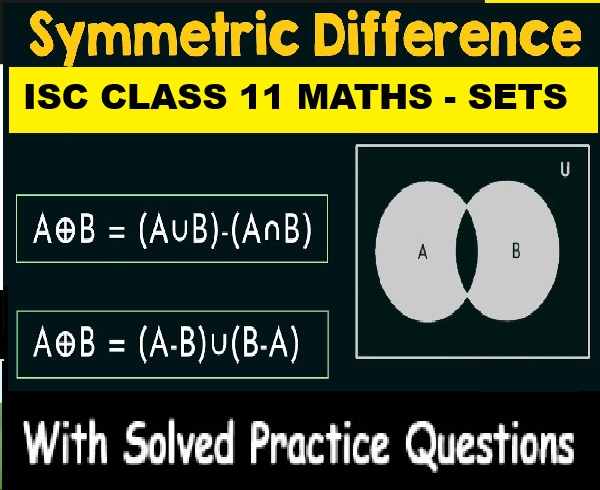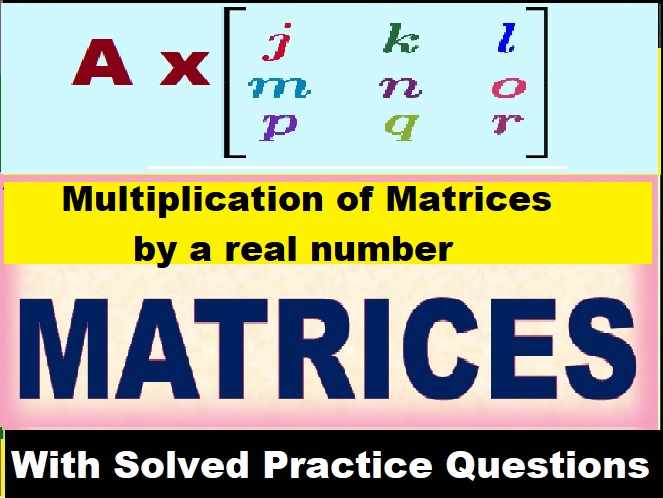Sets Class 11 OP Malhotra Exe-1G ISC Maths Solutions Ch-1 Latest editions. In this article you would learn about Symmetric Difference of two Sets. Step by step solutions of latest textbook has been given as latest syllabus. Visit official Website CISCE for detail information about ISC Board Class-11 Mathematics.

Sets Class 11 OP Malhotra Exe-1G ISC Maths Solutions Ch-1
| Board | ISC |
| Publications | S Chand |
| Subject | Maths |
| Class | 11th |
| Chapter-1 | Sets |
| Writer | OP Malhotra |
| Exe-1(G) | Symmetric Difference of two Sets. |
Exercise- 1G
Sets Class 11 OP Malhotra Exe-1G ISC Maths Solutions Ch-1 Latest editions.
Find A Δ B if
Que-1: A = {a, b, c, d}, B = {a, c, e, f}
Sol: AΔB = (A−B)∪(B−A)
A-B = {b, d}
B-A = {e, f}
AΔB = (A−B)∪(B−A)
= {b, d}∪{e, f}
= {b, d, e, f}
Que-2: A = {5, 10, 15, 25}, B = {10, 25, 30, 40}
Sol: AΔB = (A−B)∪(B−A)
A-B = {5, 15}
B-A = {30, 40}
AΔB = (A−B)∪(B−A)
= {5, 15}∪{30, 40}
= {5, 15, 30, 40}
Que-3: A = {letters of words ‘RIVER’}, B = {letters of word ‘WRITE’}
Sol: AΔB = (A−B)∪(B−A)
A = {R, I, V, E}
B = {W, R, I, T, E}
A-B = {V}
B-A = {W, T}
AΔB = (A−B)∪(B−A)
= {V}∪{W, T}
= {V, W, T}
Que-4: A = {c, a, r}, B = {m, u, t, e}
Sol: AΔB = (A−B)∪(B−A)
A-B = {c, a, r}
B-A = {m, u, t, e}
AΔB = (A−B)∪(B−A)
= {c, a, r}∪{m, u, t, e}
= {c, a, r, m, u, t, e}
Que-5: A = {x | x ∈ N, x ≤ 10}, B = {x | x is a prime number x < 6}
Sol: AΔB = (A−B)∪(B−A)
A = {1, 2, 3, 4, 5, 6, 7, 8, 9, 10}
B = {2, 3, 5}
A-B = {1, 4, 6, 7, 8, 9, 10}
B-A = {}
AΔB = (A−B)∪(B−A)
= {1, 4, 6, 7, 8, 9, 10}∪{}
= {1, 4, 6, 7, 8, 9, 10}
Que-6: A = Φ, B = {5, 7, 9, 11}
Sol: AΔB = (A−B)∪(B−A)
A-B = {Φ}
B-A = {5, 7, 9, 11}
AΔB = (A−B)∪(B−A)
= {Φ}∪{5, 7, 9, 11}
= {5, 7, 9, 11}
Que-7: If A = {3, 6, 8, 15, 19} and B = {1, 2, 6, 8, 14, 15}, then verify that AΔB = (A∪B) – (A∩B).
Sol: Given sets are :
A = {3, 6, 8, 15, 19} and B = {1, 2, 6, 8, 14, 15}
Taking RHS
A∪B = {1, 2, 3, 6, 8, 14, 15, 19}
A∩B = {6, 8, 15}
(A∪B)−(A∩B)
= {1, 2, 3, 6, 8, 14, 15, 19} − {6, 8, 15}
= {1, 2, 3, 14, 19}
Taking LHS
AΔB = (A−B)∪(B−A)
A-B = {3, 19}
B-A = {1, 2, 14}
AΔB = (A−B)∪(B−A)
= {1, 2, 3, 14, 19}
LHS = RHS
AΔB = (A∪B) – (A∩B)
Hence Proved.
–: End Sets Class 11 OP Malhotra Exe-1G ISC Maths Ch-1 Latest editions :–
Return to :- OP Malhotra ISC Class-11 S Chand Publication Maths Solutions
Thanks
Please share with your friends


